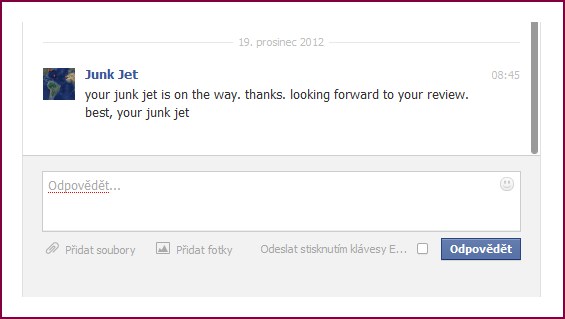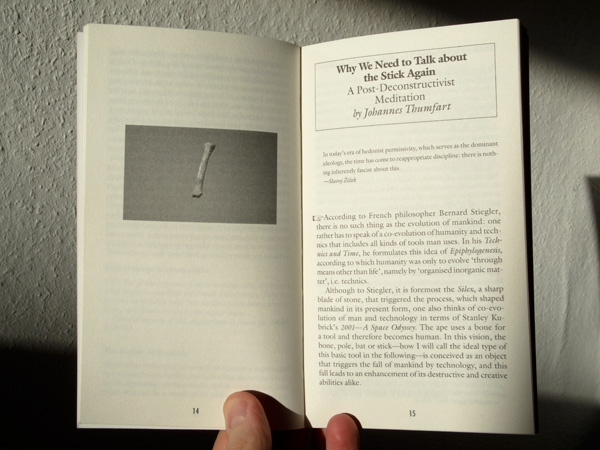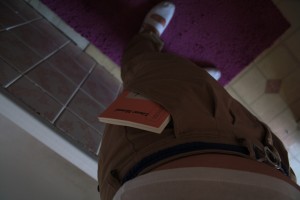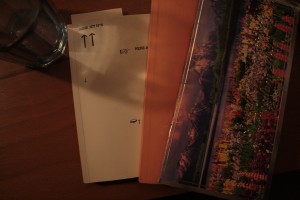If y☺u hate←҉҉↔҉↔҉↔҉↔҉↔҉҉҉҉҉ int҉er҉n҉҉e҉t, ♥►▼◄ don’t҉ e҉ve҉n҉ tr҉҉҉҉҉҉҉҉҉y t☺ l►ik҉e ♥◄ ҉this҉ bo●k ☺ → JUNK JET N°6 & Linear Manual review

Junk Jet is a zine-jet, a collaborative format set up to discuss speculative works on topics of media, aestheetics, and electronics.
Junk Jet is an irregular series of medial events, and a low-fi paper publication (including irrational special gifts) on a non-commercial scale edited by Asli Serbest and Mona Mahall (m-a-u-s-e-r) and published by their own igmade.edition.
Junk Jet is interested in counter works (and counter counter works) of counter aesthetics, tunnelling practices that show lack of any irony or fiction. It is about wild forms and found objects, about weird theories and (small) narratives, anti-fashions and non-styles, about exploring do-it-yourself works, accidental outcomes, deviant and normal aesthetic forms that result from jammed common practices, misused media, and subverted customary tools. It is about cultivating an anti heart by “introducing noise to signal”. Whereas n°1 °.° experiments with the topic of failure, or better: noise, n°2 °.° is especially into architectural and spatial works. The n°3 °.° flux us! flux you! issue focuses on temporary types, on stable happenings and unstable thoughts: boogie buildings, rolling rocks, flying architectures, provisory pyramids, lifted cellars and dug in landmarks, curtains, mobiles, house boats, bubbles, zeppelins, flying saucers … The n°4 deals with making something out of nothing and contains works that move from mumbo-jumbo to real magic and back. The […] issue n°5 °.° is an archive impossible with reflecting net.heart of internet culture. It transfers internet things from their digital space into a paper jet. (junkjet.net)
► All afore written is true true and also very telling, that’s why I did not bother to think about my own formulations and just copied and pasted the official Junk Jet description as an intro to this article. Here, we can see the tradition of ideas and the creative forces standing behind publication that is to be reviewed in this very article.
► It can also be said, that what’s written here about the famous n°5 issue can easily be applied also on the issue n°6 (yeah, I mean that stuff about Internet culture and transferring the digital good onto analogue paper good). The very current issue n°6 that was released at the magic date of 12th of December 2012 (very nice, the 12th month).
Almost magically (of course facebook played its part here), this absolutely irresistible issue appeared in my hand in the Christmas time, delivered by super-fast German slow mail with an envelope covered with smileyes. The only thing left was to read this beauty and to write a promised review on it. But as it was laying on my table next to another 2012 gorgeous book, I’ve realized that there is a link between them and that those two kind of belong together – at least in my small universe with WWW in the center of it. So I’ve decided that the best think I can do right now is to write a review on both of them, and publish it together. Starting with book that gracefully ended my year, and ending with book that with gusto started it.
As already mentioned above, the current Junk Jet follows the series of Junk Jets, special art magazines, with a number of contributions by individual contributors: artists, theoreticians, researchers, thinkers… as curated by the creative duo of Junk Jet editors: Asli Serberst and Mona Mahall. JJ has appeared in handy format DinA6 that reads well and fits comfortably not only in your hand, but also in your pocket. During its existence (first Junk Jet was released in 2007), this zine has build a reputation of art publication of extreme quality and every new issue is an event.
As said the visual arts editor of Dazed Digital, Francesca Gavin when highlighted n°6 issue as the art publication of the week: „Junk Jet is one of the best little art publications going around.“1
Junk Jets are published in igmade.edition that „is not about scientific works, conference proceedings, or glossy publications. Rather it is about risky books, which break fresh ground in concern of content and form, which work on architecture, art, and culture beyond the borders of academic tradition and of journalistic conventions.“2 About books with excellent editorial and graphic solutions, one would be tempted to add. Sounds good? And you have not even started the book yet!
Actually it was inevitable that Junk Jet n°6 appeared in my hands, since it is the kind of book that makes anybody who to some extent follows contemporary Internet art culture, or at least pretends to do so, drool with pleasure. Starting with the minimalistic m-a-u-s-e-ric design and graphic solutions, heavily soaked with computer culture inspirations and corresponding with the content of the book, and ending with the names on the back cover. Just take the names of the contributors: 0100101110101101, Adam Cruces, Andreas Angelidakis, Angelo Plessas, Blinking Girls, Emilio Gomariz, Jennifer Chan, JODI, Jon Rafman, Kareem Lotfy, Kim Asendorf, Laimonas Zakas, Olia Lialina and many others.3
Those are certainly THE names every net art freak knows about. If you are not quite adept in this world of digital (post)internet art, there is a little cheat sheet at the end of the publication: everything you need to know about each author can be learnt in their short Bio. 
In such case, Junk Jet can serve as a useful guide-post, a gateway to the world of a certain school of thought within the framework of the contemporary arts, a reason for extensive googling and a key to the room 101. In case you don’t follow the specific course of events, you will necessarily have to google, so that you were able to fully understand the contributions (see Emily’s video).
But don’t get scared: in this case, the web search is definitely not boring as well as it isn’t a result of an editorial failure, but a part of a post Internet game. Junk Jet considers its readers to be on-line – and of course they are. An interesting question thus arises: where are the borders of on-line and off-line worlds (if you think about it, it’s almost impossible to be off-line nowadays, since the Internet is thoroughly imbued within our lives and thoughts)? Where ends the Internet art and begins its representation if its idea might be so easily transferred into a physical IRL paper? “Net art” on paper is consequently re-coded within the intentions of the digital world.4 It temporarily goes down in its interactivity which it re-gains after the interaction is made by the user within another, external device (it thus doesn’t mean directly a book): by browsing to the reverse side, which contains biographic information (do you want to know more?), therefore a book allows for off-line reading on a “deserted island without electricity”. With respect to its diverse composition consisting of clearly visual material as well as short texts and logic of its formation (which can be thoughtful, however more probably it is experienced subconsciously by the contemporary netizens – i.e. those who literally live on the Internet, in other words – heavy users) the same ways of reading of a web page might be applied on a book (maybe another excess so far applied exclusively by netizens which is, however, eased by the contact with an old media which is suddenly becoming more cool than whenever before) read as a web page. )) which is supposed to be an extension of every modern reader-cyborg (laptop, workstation, smartphone).
However paper offers something that the Internet is lacking – possibility of maximum concentration and absorption of thoughts in other context. By means of recontextualization and transfer of this originally digital work into this intellectually rich environment, this one is “promoted” and its uniqueness is confirmed – it is a good thing in times of archiving internet works. While on the Internet their durability is being constantly threatened by reckless instability of this environment5, in case of a book the work finds its place within the framework of relatively stable medium and is thus documented (not archived) for future generations.
So while we may cunningly ask whether net art is still defined by the medium which in the meantime went through absolutely every single area of a human life or whether there is much more important question – the main semantic meaning and supported ways of thinking –, the fact is that the Internet art expressed by other, analogue, instruments, lacks something. (The same situation as if you take a fish out of an aquarium – it is still your goldfish, which is now much better visible, because it is not moving so much anymore and there is no cloudy water around, certain details such as reflection in its eye and slime on its tale are even more visible in this new context, but even if it might look much more beautiful in this new environment, it’s just not it. Irrespective of the fact that such fish pops off very quickly and only a fish’s little body is left, then it turns into a little skeleton and in the very end even the little skeleton is over.) In a word, if it isn’t created and perceived, at least in a certain phase, on web, it can’t make claim for being entitled as the Internet art;6 on the other side the following rule is applied: once fish, always fish. ► At the same time our distraught reviewer is the only one who uses such expression (A fish atlas is just a fish atlas.) – the publication itself anxiously keeps away from it. Why? Because when obtaining Junk Jet, we are not obtaining a fish atlas, but 3D aquarium model. And that is pretty damn difference.

Emily’s video. The publication contains just a series of screenshots – frontal shots, as if recorded on webcam – of terrified viewers, gaze dodging or blocking out their eyes, and captions. It is only after we hit the keyboard that we discover the concept of this work by Eva and Franco Mattes (aka 0100101110101101) and can fully understand the pictures.
THE GLOBAL IS BUT THE LOCAL ON WORLD TOUR…
To make the long story short: Junk Jet is not like other publications you are used to read about on this site. It is an art zine, artwork by itself comprised of other works of art. Not only of pictures and links, but also of writings that comment the visual part or are somehow intellectually connected to it and help to understand what’s going on (making the content accessible even to the uninitiated and off-line reader).
The publication is starting with screenshot from Emily’s video videos7 and e-mail (instant distance bridge) from JODI (yes, just keep staring at it so you can finally see the message :))8 moving to actual bridges, though the Google earth bridges presented by Clement Valla 9 are “somehow strange”, as are the artificial Google buildings of geometrically attractive perfect virtual GOS City by Kim Asendorf10, John Rafman’s collection of beautiful Google Street View pictures11 and manipulated Google Maps aerial shots (Olia Lialina and Dragan Espenscheid). Then we got from the virtual to a computer screens as such (i.e. to the real here, private and home for every user) with Adam Crusces http://desktop-views.com/ (presenting desktops of Daniel Keller and Jon Rafman), Hugo Scribetta and his RGB Series or Emilio Gomariz’s visual jumble cmdshift3 and stuff.
Speaking of the visual part only, because in the meantime, e. g., Nicholas O’Brian is trying to help us to understand the notions of space and place by Finding Place in the Digital and many others added their thoughts of various aspects of location, space and direction within digital work of art presented on the Internet, or location and belongeness of its viewer; about the global and about the local, by word or by art.
„Net artists realize they are making work that’s seen by audiences with highly specific knowledge, so self-reflexivity, or a conscious extra layer of reference to one’s position, is a common tool.“ 12
We slowly move from the Google imagery of world to race → gender → and religion-soaked stuff in connection to www processes, globality and locality (and artistry). Means the book is also about socio-cultural boundaries which everybody acts about as if they should be / are already not existent today, but what is actually felt is that they are hardly to be shook off. We meet the challenging Jennifer Chan’s writing on The Sociology of Hip Hop in the World of Emerging Net Art which makes me reconsider the b-side teaser to the other book I am to write about today (see the teaser below).Chan is interested in the relativity of the R-word in the art world, filling her text with juicy examples. Similarly disturbing is the Backstreet Blinkig Girls artproject, lusty looking anime icons scattered in the middle of the book, or Sophia Al-Maria bitter sigh on head shams and injustice on their she-buyers (1200 Count Head Shams from Syria and China). There are even the contributions on (the local?) shops and fashion (Cornelia and Holger Lund: Phenomena of Glocalisation) or housing (m-a-u-s-e-r: Happy Houses to Everyone, Aline Otte: Post-Colonisation in South Africa), on ruins and on public libraries.
As the pages and contributions proceeds, we are moving to more religious and spiritual themes to the end of the book. With Aids-3d presenting Wyoming as The promised Land (Absolute Vitality Inc.) reminding me of this DAV little calendar I got in US from a friend (hey, wait!)13 to the spiritualist seance A Conversation with Le Corbusier, seance by Tomas Klassnik, resulting in dictated drawings by Le Corbusier, or primitive religious pictures (Patrick Cruz: Sonoran Desert and Paradise).
„If there are differences between things that are “local” and things that are “global” those differences are accidental, unrelated, and unimportant.“ 14
![]()
The publication with subtitle HERE AND WHERE, whose leitmotif are arrows and various pointers, becomes a compass across borders. Publishing achievements like this one surely helps us to realize that if something is on-line, off-line, on paper or on LCD screen, original work or appropriation or found ready made does not really matter. Recontextualization, juxtaposition, fluxus and visual and intellectual vortex play prim here and establish great post-* reading situation, be it meta or not.
…And there comes of course always something nice with your Junk Jet – be it poster (issue n°5), mystic insert and magic mask (issue n°4) or very energetic mixtape (the right stuff to use as soundtrack to your computerwork). With this Mexican Jihad, I felt el chupacabras breathing onto my neck and its lacerating claws on my back.
Something that enabled me to enjoy experiencing this book twice as much.
Serbest, Asli – Mahall, Mona (eds.) JUNK JET N°6: HERE AND WHERE. ingmade.edition, Stuttgart 2012.
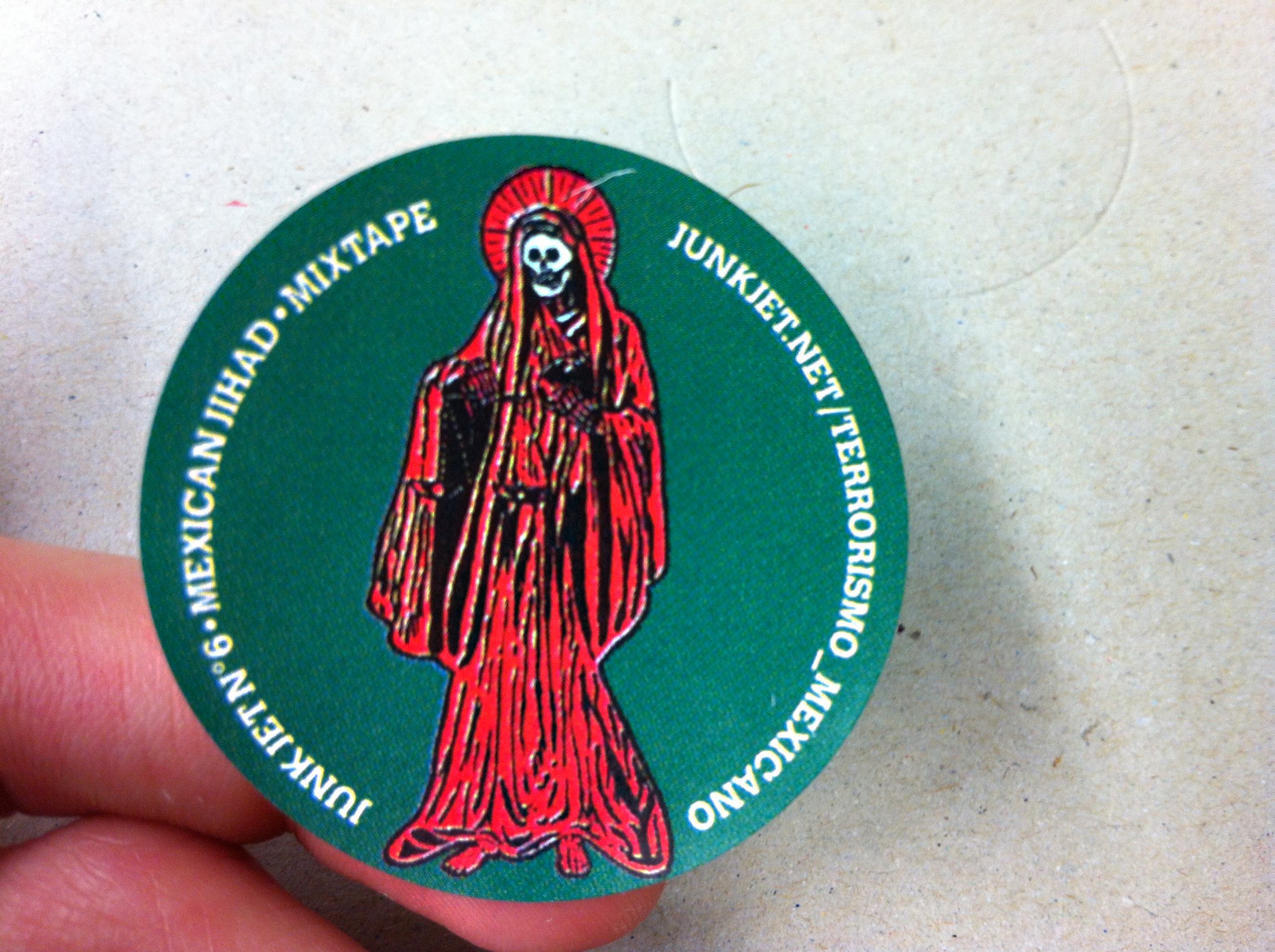
Junk Jet n°6 stickers with secret web address: ♬! Mexican Jihad: Terrorismo Mexicano…
Release date: 12.12.2012
Print run: 999 Copies
Number of pages: 144
Measurements: 148 x 105 x 8 mm (DIN-A6)
Insert: Santita Sticker and “Terrorismo Mexicano” Mixtape.
ISBN: 978-3-9814748-2-4
With contributions by:
0100101110101101, Adam Cruces, Agathe Andre, Aids-3d, Alberto Bustamante, Alejandro Crawford, Aline Otte, Andreas Angelidakis, Angela Genusa, Angelo Plessas, Aude Debout, Aureliano Segundo, Blinking Girls, Caspar Stracke, Christine Nasz and Stefanie Hunold, Clement Valla, Cornelia and Holger Lund, Emilio Gomariz, ET AL., ETC., Francesca Gavin, Golgotha, Hugo Scibetta, Jennifer Chan, JODI, Jon Rafman, Julien Lacroix, Kareem Lotfy, Kim Asendorf, Laimonas Zakas, Louis Doulas, m-a-u-s-e-r, Metahaven, Neil McGuire, Nicholas O’Brien, Nilgün Serbest, Olia Lialina and Dragan Espenschied, Patrick Cruz, Sophia Al-Maria, Superpool, Tomas Klassnik
► internet ◄
http://junkjet.net/
http://www.m-a-u-s-e-r.net/
http://www.igmade.net/order.html
facebook
bonus: Junk Jet mixer about | the thing
bonus: Junk Jet n°6 flicker photoset
bonus: speculative webpage + have a glimpse into Junk Jet n°1
bonus: see Emily’s Video by Eva and Franco Mattes on americanmedium.net
bonus: Junk Jet For Him from m-a-u-s-e-r✖JUNK✖JET= on Vimeo.
bonus: Junk Jet For Her from m-a-u-s-e-r✖JUNK✖JET= on Vimeo.
more on-line reviews on Junk Jet: „VER PARA LER #7: JUNK JET Nº6.“ [on-line] fluxo, www.ofluxo.net, 14. December 2012. [visited 7. February 2013] Accessible from WWW: < http://www.ofluxo.net/ver-para-ler-7-junk-jet-no6/>.
If you are tired of reading the Bible, try Linear Manual
IF YOU ARE TIRED OF READING THE BIBLE, TRY LINEAR MANUAL
The second book I am to talk about today is Linear Manual, published in the Winter 2012 by PAF and TLTRPreß. PAF is Festival of Film Animation (Přehlídka animovaného filmu) held annually in Olomouc, Czech Republic that, as part of its many all-year-long activities15 concentrates also on publishing anthologies and translation publications on various forms of moving image, and of course cooperates on authorial and artistic publications like Linear Manual or Lost Perspective by Jan Šrámek.16
TLTRPreß is „small & shady publishing enterprise“ established around 2011 by Czech artist Martin Kohout, who is heart, soul and hands of his publishing house. As officially claimed at the too-long-to-read facebook page, TLTRPreß has so far published „over 90kg of printed matter including photo albums, doubtful magazines, exhibition texts and indirect fetish catalogues.“ Established in Berlin around 2011, currently based in Frankfurt am Main, Germany, the location of this young house moves along with Mr. Kohout and his Macbook. So far TLTR focused mainly on art books and books with strong Kohout’s input, or accomplishing materials to his work – like handouts to his solo exhibitions Glare Inland Quiet Attachment (Exile Berlin, 2011) GIQA Report No 1 and Glare Inland Quiet Attachment 2 (Futura Prague, 2012) GIQA Report No 2 and after the first exhibition released explanatory short essay GIQA Appendix #2 or album of his exhibitions and works for The (new&extended) Administration of Guilt etc. or photo album with digitally manipulated flicker-found images.
Although Kohout designs and edits great deal of TLTRPreß books, he also with pleasure cooperates with other editors (e.g. theoretician Palo Fabuš) and designers, especially Rasmus Emanuel Svensson from PWR Paper who also designed the very book we are talking about here today. 
During his artistic residency at Nordic Artists Center in Dale, Norway, Kohout edited two books – two artistic compilations – in total: Doubting, No. 417 featuring „Ms Baggs, Ms Bonajo, Mr Brož, Mr Contreras, Mr Fabuš, Mr Gorz, Mr Kosma, Ms Laube, Mr Mortensen, Mr Pallasvuo, Mr o F F, Mr Pěchouček, Ms Pošová, Mr Proulx and Mr Troemel“ and Linear Manual with contributions by Ivan Mečl, Johannes Thumfart, Gregor Quack, Paul Haworth, Jo-ey Tang, Martin Kohout, Katharina Marszewski, Eric van der Weijde, Dieter Roelstraete, Palo Fabuš, Juliette Bonneviot, Brian Droitcour and Linda Spjut. Both publications seems to have some writings, some original artistic pictures and some appropriations, which is something we already heard in the case of Junk Jet, I almost hear you saying). Let’s closely concentrate on Linear Manual now and discover why the book is considered to be so special and why I actually bothered to write a review on it.
First: yes, Linear Manual contains contributions by several artists and authors, but unlike the Junk Jet which can be said to be curated or edited by Asli and Mona, re-contextualizing and archiving works that were mostly initially on-line together with some writings on them, Linear Manual was meant as indirect catalogue to Martin Kohout’s work. The artist invited potential contributors, whom he enriched with very specific instructions in the form of imaginary triangle whose two vertices stood for Kohout’s artworks. The third vertices was let to be imagined by the contributors, whose task was to portray what is in the middle of the triangle, and could therefore be understood as certain stimulus for given Kohout‚s works. Kohout than organized selected contributions into a fictional one day conference, with coffee breaks and final song, calling himself host more than editor. It thus seems to be on the first sight completely different type of publication, based on different principle, and this mysterious resemblance, that made me to write on both books at the same time, somewhat nonsensical. But: Linear Manual ain’t that easy: this book is multi layered.
So let’s start with the mysterious link between Junk Jet and Linear Manual I’ve had anticipated before. Simple thing s first, so we had the book as physical object here: the outer layer. Lying next to each other on my table, the books seem similar in design. Their one color light paper back covers with simple images of arrows and pointing hands (although with a stick on Kohout’s piece, the aesthetic of simple graphic symbol of pointing hand is present throughout his works as well as his representation in on-line world; and whats more – also heavily inside the book) or their book spines starting with simple arrow on the left side fit quite nice to each other when in bookshelf. They are about the same nice-fitting-into-my pocket (and hand!) size, about the same weight, they are equally thick, which I don’t call nice coincidence, because I pretty much blame the artists‘ background for this occurrence if anything. But this outer similarity of course ain’t the only reason I am talking about a link here (obviously).
While both are printed books, I would assume that Junk Jet is more about using the possibilities this medium offer, as we had been already talking about graphic design and recontextualizing stuff. In the case of the second book, it seems to be much more about the media itself (its materiality, linearity, fetishization). And I mean not only about the medium of paper or book, but also, perhaps subconsciously, about the Internet. So both books, while of different content (Kohout’s publication does not contain new media art only, but is more „old-fashioned“, with poetry, hand drawings and reprinting hand written stuff or even pieces of worn out paper with some content; on the other hand, it also literary contains computer animated video), drew on the same discourse: that one used by contemporary artists – netizens.
“Few people today remember the role once played by the stick. All memories of its necessity and exceptional status within human society have been erased by the emergence of the internet and its related tools.” Ivan Mečl
But while Junk Jet, well, might work just as well in the form of pdf, Lineal Manual has to be physically touched. Which is simply something you cannot do with your pdf! Linear Manual made me literary want to draw into the book, to take it everywhere with me, to turn the pages until they are greasy, scuffed and tattered. In other words to use the book, to enjoy the touch of the paper. Much more than my craziness, other particular factors are to blame for this: By using types of paper that are strongly contrasting and attractive to touch18, the physical presence of the book and used medium is coming to the fore, leading to emphasis on and fetishization of used medium and – in juxtaposition with the content and structure of the work – surprisingly also of the Internet, which was the feeling I was struggling with myself when reading the book.
“And while its topic is unfolding around the themes of fetish, sticks etc., the whole book as such is object of fetish, it is fetishisizing the medium of printed book (touch is very very important here) and, what’s more, Linear Manual is nice fetish of Internet.”
With Linear Manual, two things are even more interesting than its content, revolving around the theme of sticks, semantic shifts and recoding and fetish, and that is its work with medium and its structure. And I don’t have in mind the above mentioned conference-like structure explicitly set by its author, but the other, deeper structure. Because when I was, as a netizen and heavy netart freak, holding the book in my hands, I’ve realized that this particular book – which is totally something I had never experienced before – behaves like hypertext – with additional and wanna want more informations on the sides and contributions scattered throughout the book. Well, this level of meaning is somehow hidden and I’m afraid uncanny because it is not interactive book per se (anyway its strictly linear structure is highlighted in advance in the form of fictional conference).
Linear Manual is not putting the content of the Internet (like in the case of Junk Jet) on paper, but capturing its very structure!19 No wonder I was heavily wowed when I discovered the book!
No wonder I was heavily wowed when I discovered the book!
You can actually browse through Linear Manual all eternity up to its end and you will probably get never bored by it, because there is a great chance you’ll always discover something new. There is no metaphysics in it: just the lucky structure of the book, the result of which is that in the book with precise indeterminate name, under which almost anything can be imagined, can ultimately almost everything be found. It just depends on how you read and move in this multi-functional publication, whose linearity anticipated by its name is only apparent and (perhaps intentionally) confusing.
But of course, capturing/expressing Internet with a book would be example of some really wild reverse-remediation!20 And if so, this would made Linear Manual really exceptional book.21
“While Internet can be perceived as kind of manual to Kohout’s book, Linear Manual is at the same time manual to Internet and contemporary culture, in other words, a manual to today’s life.”
CONCLUSION
Thus, while Junk Jet in a certain way archived and re contextualized the content inherent to Internet as specific and progressive environment (provided the „3D model of aquarium“), the image implicitly given about it by Linear Manual resembles more an archaeological artifact or religious object. Personally, I’ll probably forever perceive stick as a religious artifact that, thanks to Linear Manual, through semantic transfer embodies the very philosophical nature of the Internet.
☛ And just by the way, Linear Manual is absolutely the only book that ever made me produce fan art.

Kohout, Martin (ed.) Linear Manual. TLTRPreß & PAF, 2012.
Featuring Ms Bonneviot, Ms Cooper, Mr Droitcour, Mr Fabuš, Mr Haworth, Ms Laube, Ms Marszewski, Mr Mečl, Mr Pieroni, Mr Quack, Mr Roelstraete, Ms Spjut, Mr Tang, Mr Thumfart, Mr Weijde and more.
Designed by Mr Svensson, hosted by Mr Kohout.
Co-published with PAF.
Edition of 55.2kg.
☛ 7 Eur
► internet ◄
http://www.tltr.biz/
www.martinkohout.com
www.pifpaf.cz
facebook
bonus: LINEAR MANUAL INSIDE THE BOOK tltr.biz PHOTOGALLERY
bonus: Linear Manual — b-sides teaser from Martin Kohout on Vimeo.
bonus: TLTRPreß launch at Motto Berlin, February 23rd, 2012 from Martin Kohout on Vimeo.
FINAL REMARK
Of course those two reviewed publications are not the only of their kind; there is much more, like e.g. the O FLUXO ISSUE#01, released in the middle of the summer, or Post Internet Survival Guide 2010 curated and designed by charming artist Katja Novitskova and many others.
Those publications poise very often on the edge of graphic design, new media and internet art and many other stuff: which is of course obvious as it can be called Post Internet art, because all those authors, editors/curators and artists always work with one (or both) eyes on the Internet. And even with their eyes closed, their heart is still out there and their bright minds always on-line.
Many thanks to Magda Hrabálková for translation help with annoyingly lengthy passage on fish.
- Gavin, Francesca. „Hung & Drawn. Visual arts editor, Francesca Gavin’s highlights of the week: from the latest copy of Junk Jet to Jon Rafman’s Brand New Paint Job“ [on-line] Dazed Digital, www.dazeddigital.com, leden 2013. [čerpáno 7. února 2013] Dostupné z WWW: < http://www.dazeddigital.com/artsandculture/article/15477/1/hung-drawn>. [↩]
- http://igmade.net/igmade_impr.html [↩]
- for the full list of contributors see the end of this review [↩]
- and the reason is that nowadays we are in such perfect symbiosis with the Internet, we use it in our everyday operations so naturally, that it’s no problem to “think by means of the Internet” for us – on the contrary, we do that often automatically, even unconsciously [↩]
- especially by rapid technological development, which does not support older works, but also by laws and users’ behaviour [↩]
- And what about mechanical fish? (Yes, exactly, they are just for playing.) [↩]
- 0100101110101101.ORG: Emily’s Video, screenshots from videos [↩]
- JODI: TTPLOLOOC://WCLi/CAL [↩]
- Clement Valla: The Universal Texture [↩]
- Kim Asendorf: GOS City (Google Open Source) – excerpts from the ongoing project GOS City [↩]
- John Rafman: 9-Eyes, Google Street Views [↩]
- Jennifer Chan: An Informal Survey of Swag. The Sociology of Hip Hop in the World of Emerging Net Art. p. 66-75 [↩]
- actually, it was using the same visuals and rhetoric [↩]
- Aureliano Segundo: We Were Never Global, p. 52-55 [↩]
- including music releases, curating exhibitions and galleries, organizing events connected to moving image and sort of promoting Czech videoart among other activities [↩]
- ŠRÁMEK, Jan. Lost Perspective. Brno: Fiume/Olomouc: Pastiche Filmz, 2012 [↩]
- actually the fist issue of Doubting ever been published, if we don’t count this more of a leaflet and today very hardly traceable preceding issue [↩]
- including the cover, for which was chosen rather untypical and sensually refreshing type of paper [↩]
- Or, in other words, in contrast to Junk Jet it deals not with organizing Internet art, but with organizing art materials in a way that is thought by the Internet. [↩]
- see KORSTEN, Saskia Isabella Maria. Reversed Remediation. How Art Can Make One critically Aware of the Workings of Media. (master thesis) University of Amsterdam, 13. August 2010. Thesis Supervisor: Dr. Edward A. Shanken. 61p. Accessible on-line: <http://dare.uva.nl/document/188776>. [↩]
- Just for the record: Martin Kohout would not probably agree on this one, because he actually did not, when I had the chance to ask him about it few months ago. Quite the contrary, he was rather surprised. It took me lot of thinking and analyzing the artistic practice of Martin Kohout and other post internet artists until I’ve realized that the beautiful and important things often emerge involuntary without their author even being aware of them or later on agreeing with them. After several months of efforts to refute my perhaps false initial impression, I am convinced about its correctness more than ever. I see it as a natural expression of the contemporary Internet logic adoption into real life of actual human beings. Which is actually something everybody does, not necessarily resulting in publications of accidentally reverse-remediated books. [↩]




